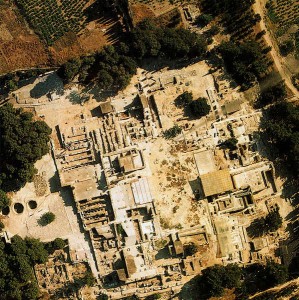And yet more labyrinths - the atmosphere here is somewhat poetic. Is this a world one can…
Labyrinth, urbanisation and social relations
This structure is neither a palace nor a labyrinth, it is a city that functions as administrative center, temple complex, workshop and storage facility all in one. The idea of its being a ‘palace’ is the invention of Sir Arthur John Evans ( 1851 – 1941) , a British archaeologist who bought the site, escavated it and restored parts of it.
The Minoan civilization was a Bronze Age civilization, named by Evans after the mythic ‘King Minos’. The Minoan culture flourished from approximately 2700 to 1450 BC. Afterwards, Mycenaean Greek culture became dominant at Minoan sites in Crete.
The most apparent characteristic of Minoan religion was that it was polytheistic and matriarchal, that is, a goddess religion; the gods were all female, not a single male god has been identified until later periods. The head of the Minoan pantheon seems to have been an all-powerful goddess which ruled everything in the universe. This deity was a mother deity, that is, her relationship to the world was as mother to offspring, which is a fundamentally different relation than the relationship of the father to his offspring.
The world for the Minoans seems suffused with the divine; all objects in the world seem to have been charged with religious meaning. The Minoans particularly worshipped trees, pillars (sacred stones), and springs. The priesthood seems to have been almost entirely if not totally female, although there’s evidence (precious little evidence) that the palace kings had some religious functions as well.
Urbanization dramatically changes social relations. In place of real, biological relationships based on kinship, urbanized cultures organize themselves around more abstract, less stable, and inherently unequal lines. In particular, urbanized society is organized around “class,” that is, economic function, rather than kinship.
Urbanization also produces a split in human experience; life is divided into a public and a domestic sphere. In small tribal societies, this split is non-existent or barely evident, but urbanization produces a marked distinction between these two spheres. Almost universally, men dominate the newly formed public sphere: administration, regulation, and military organizations. Social inequality, then, gets established along sexual lines as well as economic function. This is a dramatic and traumatic change for any society to go through; literally, the entire world view has to adapt dramatically to account for this new inequality. For instance, most religions probably began as goddess religions; the new urbanized societies, however, develop god religions in their place.
Crete, so singular in everything else, seems to have avoided this. Not only does Crete seem to be a class-based society where there is little class inequality, archaeological evidence suggests that women never ceased playing an important role in the public life of the cities. They served as priestesses, as functionaries and administrators, and participated in all the sports that Cretan males participated in. These were not backyard sports, either, like croquet. The most popular sports in Crete were incredibly violent and dangerous: boxing and bull-jumping. In bull-jumping, as near as we can tell from the representations of it, a bull would charge headlong into a line of jumpers. Each jumper, when the bull was right on top of them, would grab the horns of the bull and vault over the bull in a somersault to land feet first behind the bull. This is not a sport for the squeamish. All the representations of this sport show young women participating as well as men.
| « Asimov – urbanism taken to the future | <-- previous post | next post --> | Francis Alÿs and the city of London » |
|---|









